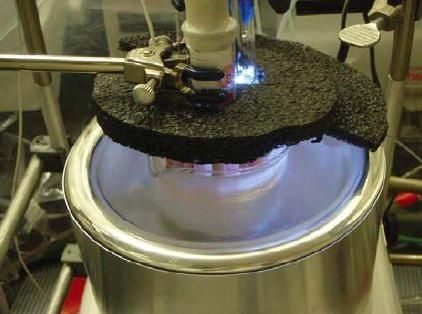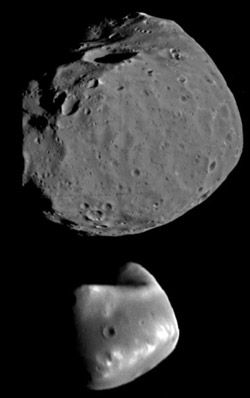Haiku Highlight the Existential Mysteries of Planetary Science
Conference-goers put into verse the ethane lakes on a Saturn moon, the orbital paths of Martian moons and a megachondrule’s mistaken identity
/https://tf-cmsv2-smithsonianmag-media.s3.amazonaws.com/filer/20130319010024Titan-Lake-small.jpg)
Science conferences are hotbeds for jargon. In fields where dissertation titles tend to have a string of polysyllabic words, followed by the requisite colon, followed by another string of polysyllabic words; where abstracts of scholarly articles are packed with the names of chemical compounds, isotope ratios and undefined program acronyms; where images are multivariate graphs of curves traced through dots crisscrossed with error bars, the instances where an outside person can read a summary of science written for scientists by scientists are naturally rare. And why not go whole hog with the language of your peers when you’re at a conference sharing work with your peers?
But several summaries of scientific presentations given at this year’s 44th annual Lunar and Planetary Science Conference (LPSC), currently being held in The Woodlands, Texas, are not only easy to follow—they are beautiful. They cut through layers of complexity to strike at the very heart of the topics at hand. That’s because they are written in haiku format.
Haiku, a terse form of Japanese poetry, have three lines. The first can only be five syllables long. The second can bleed a little longer to seven syllables. The last returns to five syllables. For the past decade or so, some creative LPSC attendees have been submitting haiku as summaries for their talks or poster sessions. These haiku fulfill a conference requirement, that in addition to traditional abstracts which are about two pages long and can be full of acronyms and chemical formulas, attendees who want to present their work must also submit a one- or two-sentence teaser to be printed in the meeting’s programs along with their presentation’s title.
This teaser, akin to a tweet, already forces scientists to be their pithiest. But a haiku lets them do this with style, grace and at times levity.
Thirty-two haikus were printed in the program this year. Below are a few of our favorites:
1) The Transcendence of Benzene on Titan
Ethane and methane are gases on Earth—the former is a derivative of natural gas, and the latter is the main component of natural gas itself. On Saturn’s moon Titan, temperatures average a mere 94 Kelvin (roughly -290 degrees Fahrenheit), forcing these compounds into a liquid state. In fact, they are Titan’s analogues to water—in 2004, the Cassini-Huygens space probe discovered ethane and methane carve rivers and pool in lakes. Also on the surface of Titan are small amounts of benzene, a sweet-smelling petrochemical that is composed of six carbon atoms joined in a ring, each attached to one hydrogen atom. Though a liquid on Earth, benzene on Titan condenses into waxy, ice-like chunks.
In a talk today entitled, “Laboratory Investigation of Benzene Dissolving in a Titan Lake,” Michael Malaska of the Jet Propulsion Laboratory describes how he and co-investigator Robert Hodyss froze benzene and dropped it into liquid ethane encased within an experimental apparatus they affectionately dubbed the “FrankenBeaker,” a device that ensures that samples keep their chill conditions. They found that the liquid ethane eats away at the benzene solids, leading them to suppose that much like how Earth has limestone caves, ethane pools could etch cavities within benzene shores of Titan’s lakes.
Their summary is our favorite:
Tiny little rings
Drifting in a Titan lake
Fade away slowly.
Through this, the benzene on Titan has an almost ephemeral quality, underscored by the fleeting meter of the haiku. And the idea that something tangible exists but decays over time mirrors our world: people are born and then die, civilizations rise and fall, the mightiest mountains will crumble into dust, our planet will get consumed by the eventual explosion of the Sun. But it is the juxtaposition of the small and the large—the “tiny” and the “Titan”—that is so compelling. Are we not all tiny molecules floating in the vastness of space and time, floating until we eventually fade from existence?

“Using a haiku for the short program description seemed like a fun challenge to fit an idea into such a short medium. It really makes you distill the idea down to it’s essentials,” Malaska explains over email. He admits that his abstract is “pretty intense and detailed,” but that writing a haiku—his first for LPSC—seemed like a fun idea. “I don’t normally write haikus or poetry. But I did come up with a Titan rap at one point: ‘Dunes of plastic/it’s fantastic/gettin’ all sticky/and electrostatic.’”
“One of my nieces used to play the ‘three word game’ with me,” he adds. “You can only speak in sentences of three words. This really forces you to think about what is essential. It is interesting what (and how) you can convey complex thoughts and concepts into just the essentials. It’s a great tool to help write concise sentences and presentations.”
2) The fated paths of Phobos and Diemos
Phobos and Diemos, the two moons of Mars, trace paths in Martian sky, at times going between the Curiosity rover and the Sun. Images of the moons traveling across the Sun’s face, snapped by Curiosity, allowed Mark Lemmon of Texas A&M University and his colleagues from around the country to analyze in detail the exact tracks of these orbits and how the paths evolve through time. For example, Phobos’s trajectory is slowed by it’s attraction to Mars, causing its orbit to decay. Their poster, which will be presented on Thursday, is titled, “Astrometric Observations of Phobos and Deimos During Solar Transits Imaged by the Curiosity Mastcam.” Their haiku is strikingly mysterious:

Two moons in the sky
wandering by the Sun’s face
their orbits constrained.
The two moons wander, but not aimlessly—their paths are fated. Taken outside of the context of science, I can’t help but think that the poem is bestowing some enigmatic wisdom about the interaction of couples in a relationship. Seek sunshine but don’t get too close to it? Or, if the two of you are fettered to a certain path, bright times are only something you see in passing?
“I was considering the absurdity of writing a summary of an abstract of a paper/talk/poster. It occurred to me to be creative in response to absurdity,” Lemmon writes in an email. He adds, “the haiku reinforced the concept that the subject was nature, not data, and in this case that juxtaposition was key.”
He continues, “I think any form that constrains the expression of an idea helps that expression, at least if it is allowed at all. To describe your poster in one word is not useful. But this allows you to focus on the ideas that should get people to look at the longer-form expression. A dry statement (like the title) can be short and will inform. A second dry statement adds little. Trying to measure up to the standards of an art form, I hope, at least amused some and maybe created interest in what is in the poster (which is quite non-poetic, sadly).”
3) Mistaken identity
Emma Bullock, of Smithsonian Institution’s National Museum of Natural History, along with colleagues from the University of Tennessee gives our next haiku, which is sure to bring a smile to your face:
Oh, “megachondrule”
We were sadly mistaken
You are impact melt.
In her poster, “Allende 10 B 41: Megachondrule, or Impact Melt Clast?” presented today, Bullock reports on the examination of a slice of the Allende meteorite, a carbonaceous chondrite that fell to Earth in 1969 over Mexico. Chondrites are thought to represent ancient material from a planetesimal or other body that never had a chance to separate into a crust, mantle and core. Other researchers had previously examined a large rounded object in the slice of meteor: the object, about 1.6 centimeters in diameter, was thought to be a megachondrule–a relatively big nugget of once-molten material that many point to being one of the earliest solids to form in our solar system. Exciting stuff! But alas, it wasn’t meant to be.
“The short abstract is just designed to encourage people to come to your presentation,” Bullock writes in an email. “So why not have fun with it? I have a few other friends who also took up the challenge, and its been fun trying to find the other haiku.”
4) The secrets of old spacecraft
Long-time LPSC haiku veteran Ralph Lorenz writes in an email,”Composition mirrors the scientific process—although acquiring new information at first makes things complicated, the ultimate goal is to find a simple set of rules or processes that explains all that we see. A haiku is a bit like that, a minimalist description.”
Lorentz, from the John Hopkins Applied Physics Laboratory, and his co-author examined data from seismometers that bounced onto Mars as part of the Viking landers, launched in the mid 1970s. They weren’t searching for earthquakes—instead they sought to see if dust devils whirling over the sensor could possibly be seen in its data or if more run-of the-mill wind gusts obscured dust-devils’ signatures. The haiku, a summary of their poster “Viking Seismometer Record: Data Restoration and Dust Devil Sea,” presented today, speaks for itself:
Whispers from the past
Viking mostly felt the wind
Let’s all look closer.
Other favorites include “Impact shock heats Mars / Core can’t convect, dynamo dies / Back in a billion?”, for a poster presented by Jafar Arkani-Hamed of the University of Toronto, and “Rocks rain from above / Many ready at the reins / New methods reign too,” for a poster presented by Marc Fries (of Galactic Analytics LLC and the Planetary Science Institute) on the detection of meteorite impacts by weather radars and seismometers. Incidentally, when asked what he thought about writing haiku, Fries replied:
Ah, distill a work
Drop by drop to syllables
To freshen the mind.
/https://tf-cmsv2-smithsonianmag-media.s3.amazonaws.com/accounts/headshot/mohi-kumar-240.jpg)
/https://tf-cmsv2-smithsonianmag-media.s3.amazonaws.com/accounts/headshot/mohi-kumar-240.jpg)